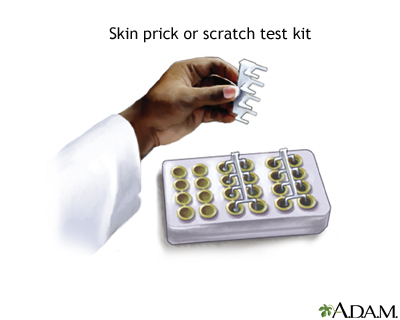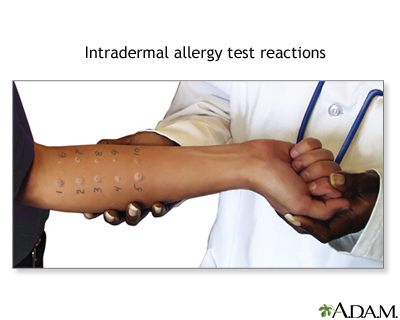Allergy skin tests are used to find out which substances cause a person to have an allergic reaction. These substances are called allergens.
How the Test is Performed
There are three common methods of allergy skin testing.
The skin prick test involves:
- Placing a small amount of substances (allergens) that may be causing your symptoms on the skin, most often on the forearm, upper arm, or back.
- The skin is then pricked so the allergen goes under the skin's surface.
- The health care provider closely watches the skin for swelling and redness or other signs of a reaction. Results are usually seen within 15 to 20 minutes.
- Several allergens can be tested at the same time.

The intradermal skin test involves:
- Injecting a small amount of allergen into the skin.
- The provider then watches for a reaction at the site.
- This test is more likely to be used to find out if you're allergic to bee venom or penicillin. Or it may be used if the skin prick test was negative and the provider still thinks that you're allergic to the allergen.

Patch testing is a method to diagnose the cause of skin reactions that occur after the substance touches the skin:
- Possible allergens are taped to the skin for 48 hours.
- The provider will look at the area in 72 to 96 hours.
How to Prepare for the Test
Before any allergy testing, the provider will ask about:
- Illnesses
- Where you live and work
- Lifestyle
- Foods and eating habits
Medicines that contain antihistamines - whether prescription or over-the-counter - can change the results of skin tests. Your provider will tell you which medicines to avoid and when to stop taking them before the test. If you don't want to stop taking a medicine due to the severity of your symptoms, please tell your provider. They may be able to use a different approach to allergy testing.
You don't need to stop taking non-antihistamine medicines such as asthma inhalers, montelukast, and nasal steroids.
How the Test will Feel
Skin tests may cause very mild discomfort when the skin is pricked. Positive skin tests will become red, itchy and swollen like a bug bite.
You may have symptoms such as itching, a stuffy nose, red watery eyes, or a skin rash if you're allergic to the substance in the test.
In rare cases, people can have a whole-body allergic reaction (called anaphylaxis), which can be life threatening. This usually only occurs with intradermal testing. Your provider will be prepared to treat this serious response.
Patch tests may be irritating or itchy. These symptoms will go away when the patch tests are removed.
Why the Test is Performed
Allergy tests are done to find out which substances are causing your allergy symptoms.
Your provider may order allergy skin tests if you have:
- Hay fever (allergic rhinitis) and asthma symptoms that are not well controlled with medicine
- Hives and angioedema
- Food allergies
- Skin rashes (dermatitis), in which the skin becomes red, sore, or swollen after contact with the substance
- Penicillin allergy
- Venom allergy
Allergies to penicillin and related medicines are the only medicine allergies that can be tested using skin tests.
The skin prick test may also be used to diagnose food allergies. Intradermal tests are not used to test for food allergies because of high false-positive results and the danger of causing a severe allergic reaction.
Normal Results
A negative test result means there were no skin changes in response to the allergen. This negative reaction most often means that you are not allergic to the substance.
In rare cases, a person may have a negative allergy test and still be allergic to the substance.
What Abnormal Results Mean
A positive result means you reacted to a substance. Your provider will see a red, raised area called a wheal.
Often, a positive result means the symptoms you're having are due to exposure to that substance. A stronger response means you are likely more sensitive to the substance.
People can have a positive response to a substance with allergy skin testing, but not have any problems with that substance in everyday life. Food allergy testing particularly carries a high risk of these false positive results.
Skin tests are usually accurate. But, if the dose of allergen is large, even people who are not allergic will have a positive reaction.
Your provider will consider your symptoms and the results of your skin test to suggest lifestyle changes you can make to avoid substances that may be causing your symptoms.
Alternative Names
Patch tests - allergy; Scratch tests - allergy; Skin tests - allergy; RAST test; Allergic rhinitis - allergy testing; Asthma - allergy testing; Eczema - allergy testing; Hayfever - allergy testing; Dermatitis - allergy testing; Allergy testing; Intradermal allergy testing
References
Chiriac AM, Bousquet J, Demoly P. In vivo methods for the study and diagnosis of allergy. In: Burks AW, Holgate ST, O'Hehir RE, et al, eds. Middleton's Allergy: Principles and Practice. 9th ed. Philadelphia, PA: Elsevier; 2020:chap 67.
Homburger HA, Hamilton RG. Allergic diseases. In: McPherson RA, Pincus MR, eds. Henry's Clinical Diagnosis and Management by Laboratory Methods. 24th ed. Philadelphia, PA: Elsevier; 2022:chap 56.
Nadeau KC. Approach to the patient with allergic or immunologic disease. In: Goldman L, Cooney KA, eds. Goldman-Cecil Medicine. 27th ed. Philadelphia, PA: Elsevier; 2024:chap 230.
Review Date 3/31/2024
Updated by: Deborah Pedersen, MD, MS, Allergy & Asthma Care, PC, Taunton, MA. Review provided by VeriMed Healthcare Network. Also reviewed by David C. Dugdale, MD, Medical Director, Brenda Conaway, Editorial Director, and the A.D.A.M. Editorial team. Editorial update 08/06/2025.






